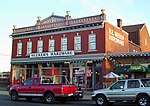Germantown, Danbury, Connecticut
Connecticut geography stubsDanbury, ConnecticutGeography of Danbury, ConnecticutNeighborhoods in ConnecticutPopulated places in Fairfield County, Connecticut ... and 1 more
Use mdy dates from April 2024
Germantown is a neighborhood in the city of Danbury, Fairfield County, Connecticut, United States. This section is on the eastern side of Danbury, with Hospital Avenue as its main thoroughfare. It is named after the German immigrants who lived there during the 19th century to work in Danbury's hat factories. The large German population in the area led to it being known as Germantown.
Excerpt from the Wikipedia article Germantown, Danbury, Connecticut (License: CC BY-SA 3.0, Authors).Germantown, Danbury, Connecticut
Fourth Street, Danbury
Geographical coordinates (GPS) Address Nearby Places Show on map
Geographical coordinates (GPS)
| Latitude | Longitude |
|---|---|
| N 41.4081504 ° | E -73.4423441 ° |
Address
Fourth Street 4
06810 Danbury
Connecticut, United States
Open on Google Maps







